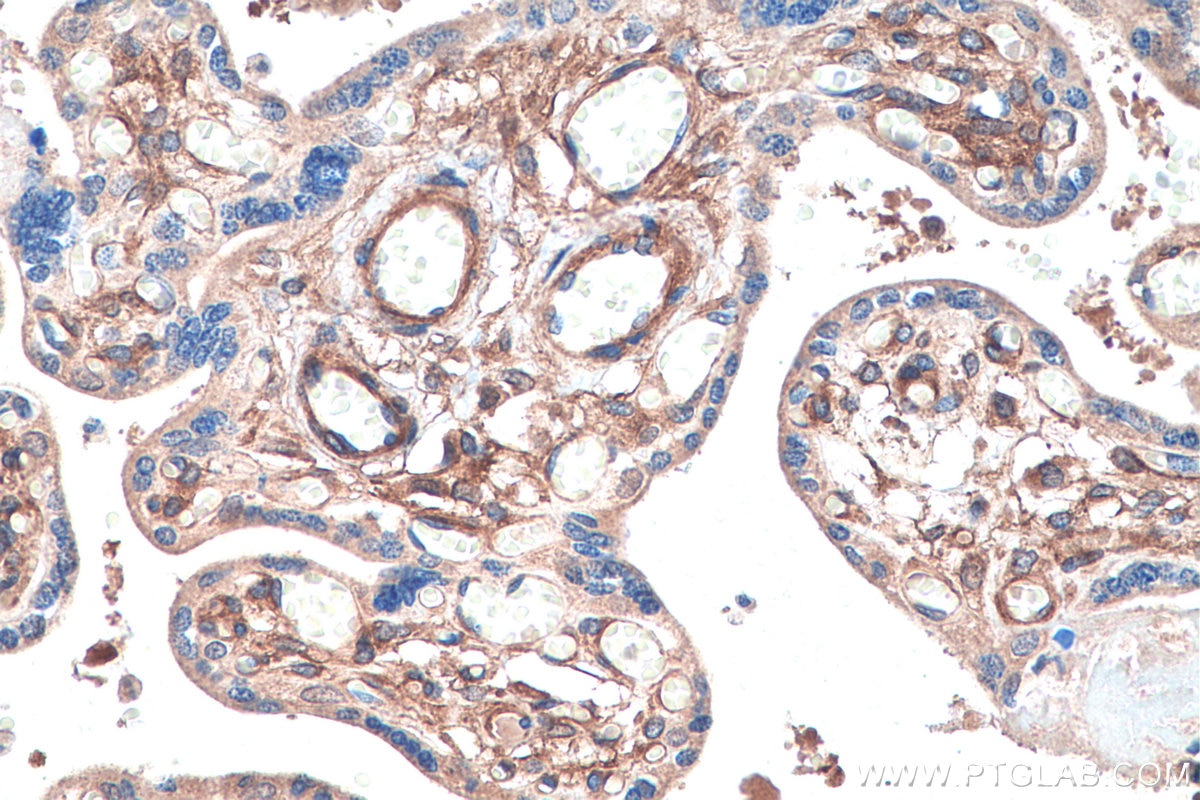Validation Data Gallery
Tested Applications
| Positive WB detected in | mouse lung tissue |
| Positive IP detected in | mouse lung tissue |
| Positive IHC detected in | human placenta tissue Note: suggested antigen retrieval with TE buffer pH 9.0; (*) Alternatively, antigen retrieval may be performed with citrate buffer pH 6.0 |
Recommended dilution
| Application | Dilution |
|---|---|
| Western Blot (WB) | WB : 1:2000-1:10000 |
| Immunoprecipitation (IP) | IP : 0.5-4.0 ug for 1.0-3.0 mg of total protein lysate |
| Immunohistochemistry (IHC) | IHC : 1:2000-1:8000 |
| It is recommended that this reagent should be titrated in each testing system to obtain optimal results. | |
| Sample-dependent, Check data in validation data gallery. | |
Published Applications
| KD/KO | See 2 publications below |
| WB | See 39 publications below |
| IHC | See 6 publications below |
| IP | See 1 publications below |
Product Information
13449-1-AP targets PDGFR beta/CD140b in WB, IHC, IP, ELISA applications and shows reactivity with human, mouse, rat samples.
| Tested Reactivity | human, mouse, rat |
| Cited Reactivity | human, mouse, rat |
| Host / Isotype | Rabbit / IgG |
| Class | Polyclonal |
| Type | Antibody |
| Immunogen |
CatNo: Ag4285 Product name: Recombinant human PDGFRB protein Source: e coli.-derived, T-HIS Tag: 6*His Domain: 755-1106 aa of BC032224 Sequence: LDMKGDVKYADIESSNYMAPYDNYVPSAPERTCRATLINESPVLSYMDLVGFSYQVANGMEFLASKNCVHRDLAARNVLICEGKLVKICDFGLARDIMRDSNYISKGSTFLPLKWMAPESIFNSLYTTLSDVWSFGILLWEIFTLGGTPYPELPMNEQFYNAIKRGYRMAQPAHASDEIYEIMQKCWEEKFEIRPPFSQLVLLLERLLGEGYKKKYQQVDEEFLRSDHPAILRSQARLPGFHGLRSPLDTSSVLYTAVQPNEGDNDYIIPLPDPKPEVADEGPLEGSPSLASSTLNEVNTSSTISCDSPLEPQDEPEPEPQLELQVEPEPELEQLPDSGCPAPRAEAEDSFL 相同性解析による交差性が予測される生物種 |
| Full Name | platelet-derived growth factor receptor, beta polypeptide |
| Calculated molecular weight | 1106 aa, 124 kDa |
| Observed molecular weight | 160-180 kDa |
| GenBank accession number | BC032224 |
| Gene Symbol | PDGFR beta |
| Gene ID (NCBI) | 5159 |
| RRID | AB_2162644 |
| Conjugate | Unconjugated |
| Form | |
| Form | Liquid |
| Purification Method | Antigen affinity purification |
| UNIPROT ID | P09619 |
| Storage Buffer | PBS with 0.02% sodium azide and 50% glycerol{{ptg:BufferTemp}}7.3 |
| Storage Conditions | Store at -20°C. Stable for one year after shipment. Aliquoting is unnecessary for -20oC storage. |
Background Information
PDGFRs are receptor tyrosine kinases with an extracellular ligand-binding domain and a cytoplasmic enzymatic domain. The signaling activity of PDGFRs is tightly regulated by an autoinhibitory allosteric conformation, and requires ligand-induced receptor dimerization at the cell surface to alleviate autoinhibition and achieve physiological activity (PMID: 21664579). PDGFR beta (platelet-derived growth factor receptor- β)/CD140b is a constitutive marker expressed by ASCs in the angiogenic behavior of human retinal endothelial cells (HREs). CD140b (PDGFRβ) plays a crucial role in controlling the intrinsic proliferation (PMID: 30976657)
Protocols
| Product Specific Protocols | |
|---|---|
| IHC protocol for PDGFR beta/CD140b antibody 13449-1-AP | Download protocol |
| IP protocol for PDGFR beta/CD140b antibody 13449-1-AP | Download protocol |
| WB protocol for PDGFR beta/CD140b antibody 13449-1-AP | Download protocol |
| Standard Protocols | |
|---|---|
| Click here to view our Standard Protocols |
Publications
| Species | Application | Title |
|---|---|---|
ACS Nano Supramolecular Hydrogel Microspheres of Platelet-Derived Growth Factor Mimetic Peptide Promote Recovery from Spinal Cord Injury | ||
Dev Cell PDGF signaling inhibits mitophagy in glioblastoma stem cells through N6-methyladenosine.
| ||
Cell Rep Selective induction of human renal interstitial progenitor-like cell lineages from iPSCs reveals development of mesangial and EPO-producing cells | ||
J Mol Cell Biol BMP4 mediates the interplay between adipogenesis and angiogenesis during expansion of subcutaneous white adipose tissue. | ||
Br J Cancer Inhibition of PFKFB3 in HER2-positive gastric cancer improves sensitivity to trastuzumab by inducing tumour vessel normalisation. | ||
Neurotherapeutics A switch in the pathway of TRPC3-mediated calcium influx into brain pericytes contributes to capillary spasms after subarachnoid hemorrhage |




